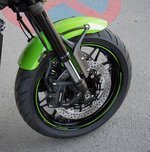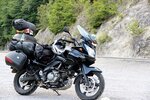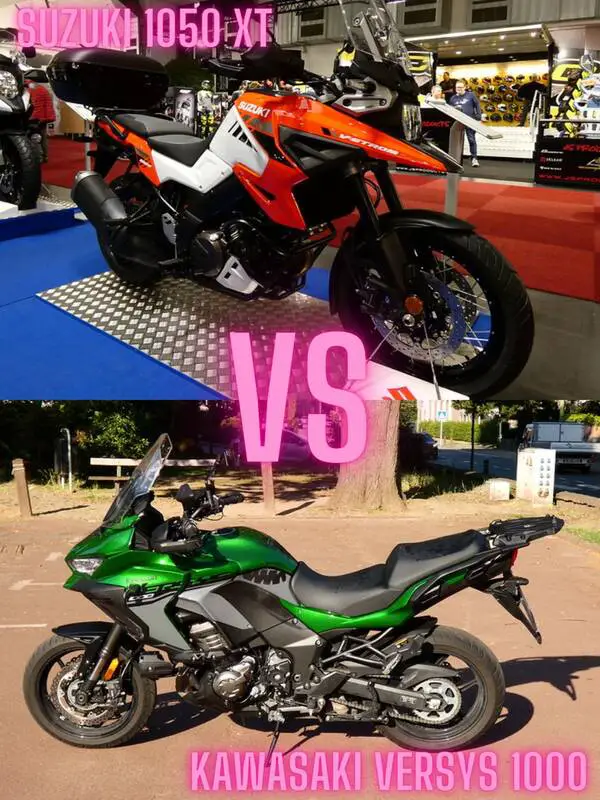As someone who’s never been fond of boundaries, touring bikes are my sweet escape. And two such bikes, the Kawasaki Versys 1000 and the Suzuki V-Strom 1050XT, recently piqued my interest.
Kawasaki’s Versys 1000 SE LT+ is a touring bike meant for the open road, with a top speed of 240 kmph. Suzuki’s V-Strom 1050XT is a similar bike, but its top speed is 201 kmph. On a regular trip, you wouldn’t even notice the difference.
So, how do you compare two bikes that are so similar? I’ve done the hard work for you. Here’s my ultimate Kawasaki Versys 1000 vs. Suzuki V-Strom 1050 XT review.
Industry History:
Kawasaki:
Kawasaki has a long history in the automotive industry. It started as a small innovative project by Shozo Kawasaki that soon grew into the company we know today. Kawasaki built its first motorcycle somewhere around 1962. And it now manufactures motorcycles, engines, aircraft, and a host of other heavy machinery.
Suzuki:
Who doesn’t know the name of Suzuki, the Japanese multinational automotive giant? Having its humble beginnings as a loom factory, Suzuki built its prototype automobile in 1937. But it wasn’t until 1954 that it started producing motorcycles by the thousands. And soon enough, the company became as diverse and renowned as it is today.
Kawasaki Versys 1000 vs. Suzuki V-Strom 1050 XT – An Overview:
Kawasaki Versys 1000:
The Kawasaki Versys 1000 is a touring bike made for those who love adventure. It features a DOHC engine with several Power Modes and an electronically controlled ignition. It’s a bike that’s made just for the open road. But that doesn’t mean you can’t take an off-road detour with it every once in a while.
Hence, it’s got excellent handling around corners with a stronger and more adjustable suspension. This bike is made to conquer freeways and interstates.
Suzuki V-Strom 1050XT:
The Suzuki V-Strom 1050XT is described as an “adventure” bike. It’s one of V-Strom’s flagship models that’s engineered for long open roads. It features a unique slim design, a rarity on touring bikes. Moreover, the lack of bulk makes it ride faster and smoother through any terrain of your choice. Off the road, it doesn’t pack a lot of potentials. But on the road, it outperforms competing motorcycles. Made for venturing through the wilderness, the V-Strom is an adventure in itself.
Comparison Table:
| Features | Kawasaki Versys 1000 | Suzuki V-Strom 1050 XT |
| Fuel & Vehicle Type | Gasoline Touring Bike | Gasoline Touring Bike |
| Fuel Tank Capacity | 21 liters | 20 liters |
| Displacement | 1043 cc | 1037 cc |
| Max Power | 118.36 hp | 106 hp |
| Max Torque | 75.23 lb.-ft | 74 lb.-ft |
| RPM @ Max Torque | 7500 | 6000 |
| Seating Capacity | 2 | 2 |
| Weight | 255 kg | 247 kg |
| Gear Transmission | 6-speed | 6-speed |
| Rear & Front Suspension | Front: 43mm inverted fork Rear: Horizontal back-link New Uni-Track | Front: Inverted telescopic Rear: Link-type single shock |
| Rear & Front Wheel Size | Front: 17” Rear: 17” | Front: 17” Rear: 17” |
| Seat Type | Two-tiered | Two-tiered |
Engine:

The first aspect I wanted to compare in my Kawasaki Versys 1000 vs. Suzuki V-Strom 1050 XT review was the engine. It’s the heart of any motor vehicle. And while the engines of the two bikes looked pretty similar, they were in no way the same in terms of performance.
Kawasaki Versys 1000 uses a 4-stroke 4-cylinder DOHC engine that is liquid-cooled. DOHC engines are highly revered for their simplicity and better airflow. And being liquid-cooled, it’s a lot easier to maintain and can deliver higher torques of up to 75.2 lb.-ft.
This torque allows it to reach a top speed of about 240 kmph, typical for most adventure bikes. Above 5,500 rpm, the engine does get a bit noisy. But don’t forget you’ll be in top gear at around 144 kmph. You can’t expect your engine to be whisper quiet.
In comparison, you can see just how relatively weak the V-Strom’s engine is. The Suzuki V-Strom 1050XT also uses a liquid-cooled DOHC engine. However, it’s a V-twin engine that delivers 73 lb.-ft of torque and has a top speed of about 201 kmph.
The stark 40 kmph difference between the top speeds of the Kawasaki vs. Suzuki leaves no doubt that the Kawasaki has the stronger engine. If you were using this bike for cruising or touring, the difference in top speed wouldn’t matter much. But if you’re using it for adventuring, speed is all that matters.
For this reason, it’s safe to say that the Kawasaki Versys 1000 has a more powerful engine. However, if you’re not worried about top speed, both the bikes are good choices for their similar torques and engines.
Weight:
Weight is an often overlooked quality factor, but it’s important nonetheless. A bike with a balanced weight will be easier to handle and more comfortable to ride on.
The Kawasaki Versys 1000 has a kerb weight of 255 kilos (562.2 pounds). And the kerb weight of the Suzuki V-Strom is 247 kilos (544.6 lbs.). As you can see, there’s not a lot of difference between the two.
However, it’s not so much about weight as it is about balance. And the Kawasaki can maintain its balance pretty well. However, I must say that it is a lot easier to handle when you’re riding at slow RPMs. At higher RPMs, though, you’ll face a significant learning curve.
That’s not the case with the Suzuki V-Strom 1050XT. Although the bike feels a lot bulkier, it’s mostly superficial. It’s a lot easier to handle around corners and curbs. And for off-roading, that’s precisely what you want.
And that’s why the Suzuki V-Strom 1050XT is better for its weight.
Suspension:

Handling is one thing, but suspension completely changes how you feel the road. In this regard, I took a look at the suspension featured on the Kawasaki Versys 1000 vs. Suzuki V-Strom 1050 XT. And I noticed some significant differences.
Starting with the Kawasaki, it features a 43-mm inverted fork. It has adjustable rebound, compression, and spring preload. In simpler terms, you get a lot more adjustability here than competing adventure bikes. Additionally, there’s KECS-control. It’s Kawasaki’s pioneer technology for an electronically controlled suspension. As for the rear, it’s a New Uni-Trak gas-charged shock with the same amount of adjustability.
As for the Suzuki, the front suspension is an oil-damped inverted telescopic shock with a coil spring. And the rear suspension is almost the same, except that it’s a link-type suspension. To put things into perspective, I found that the suspension is more suited for on-the-road applications. Off the road, it doesn’t seem to be competitive.
Though, weight plays a significant role here. Since the Suzuki V-Strom is easier to handle at higher RPMs, the suspension is a lot more road-oriented.
Otherwise, Kawasaki’s suspension is far more superior and adjustable. Plus, it works just as smoothly off-road as it does on-road.
Ergonomics:
So, we’ve established how the Kawasaki Versys 1000 vs. Suzuki V-Strom 1050 XT differ in performance. But what about ergonomics?
Ease-of-use on the Suzuki V-Strom comes in the form of an adjustable seat. The height can be adjusted from 850 mm to up to 870 mm. Admittedly, the seat isn’t straightforward to adjust – you’ll be spending up to 5 minutes simply getting the seat set up. However, once the job is done, the seat sits quite securely.
The Suzuki V-Strom’s seat is relatively thin and not very comfortable. The pillion seat is a bit more padded. But the rider’s seat seems to be quite thin. Perhaps they made the seat thinner due to just how bulky the rest of the bike is.
Kawasaki’s case is a whole other story. The seat is not only spacious but also feels softer and deeper than on the Suzuki. On short rides, you’ll hardly notice the difference. But on longer rides, the seat will speak for itself.
Aside from the seat, your posture is mostly straight on both the bikes, with your legs bent at about 60 degrees. This is typical of adventure bikes.
Due to the comfort of the seat, the Kawasaki wins this round.
Electronics:
Although bikes are primarily mechanical machines, they do work on a lot of electronic components. Perhaps no other bike could be a better example of this than the Kawasaki Versys 1000. It features electronic throttle valves along with an electronic Cruise Control function.
But that’s not all.
You also get Kawasaki Traction Control (KTRC) and Kawasaki Cornering Management Function (KCMF). Both of these are Kawasaki’s proprietary technologies and help maintain a stable and consistent ride.
In addition to that, Kawasaki also features 4 Power Modes, including Rain and Manual. These modes control the traction, power consumption, and suspension (except for the Manual/Rider mode).
Kawasaki’s technologies are beyond par, but that doesn’t mean the Suzuki V-Strom 1050XT is far behind. It features Cruise Control, Slope Dependent Control System, and a Load Dependent Control System.
Additionally, there’s the Hill Hold System and the Motion Track Anti-Lock System. Along with that, you get a Combination Brake System with two ABS sensitivity options. And all of that comes with a multi-function LCD.
Since the Kawasaki features more controls and 4 Power Modes, it’s the better choice for its electronics.
Aesthetics and Looks:

In terms of pure looks, the Kawasaki Versys 1000 vs. Suzuki V-Strom 1050 XT look quite similar. The Kawasaki features a more subtle design with rounded edges and a shark-beak at the front, common among adventure bikes. The seat is two-tiered with a pillion seat at the back and a small bump-stop behind the driver’s seat.
Besides, the Suzuki V-Strom has a more “in-your-face” design, with sharp edges and a slim body. Although the engine looks quite similar to that on the Kawasaki, it’s a lot slimmer and covered. One other difference you’ll notice is the beak at the front, which appears to be larger on the Suzuki.
Overall, Suzuki is similar to what an adventure bike is for: moving effortlessly through unpromising terrain.
Pricing:
Now for what most of you had been waiting for: the price. Comparing the prices of the Kawasaki Versys 1000 vs. Suzuki V-Strom 1050 XT, the Suzuki is cheaper. That’s not to say that it’s the better choice for the price. But when you consider the slimmer design and lighter weight, you can see why the price is slightly lower.
And the Suzuki isn’t too bad for the price you get it at. It features multiple technologies, some of which are patented by Suzuki itself. Add that to the historical Suzuki beak design, and you get a bike that’s worth every penny.
As for financing, the Suzuki provides a better financing option at zero down payment over a term of 60 months. Compared to that, Kawasaki also offers no interest, along with 0% APR, but only for the first 12 months. After that, the APR can rise to 15%. For this reason, Suzuki certainly has better pricing.
Kawasaki Versys 1000 vs. Suzuki V-Strom 1050 XT – The Similarities:
The Kawasaki Versys 1000 vs. Suzuki V-Strom 1050XT share a lot of similarities as well, such as:
Fuel and Vehicle Type:
While they certainly differ in their power outputs and top speeds, both bikes are touring bikes. They’re mostly engineered for on-road applications, though the Kawasaki also works off-road. Being tour bikes, they’re made with extra storage space at the back and can handle a lot more weight than other bikes. Additionally, they both use gasoline.
Engine and Performance:

Kawasaki and Suzuki have their differences in performance. But if you look at other factors such as Cruise Control and Traction Control, they’re both able to optimize their performance. And unless you’re riding on an open road, the difference in top speeds isn’t too stark.
Plus, despite one being slightly heavier than the other, they’re quite easy to handle at legal speeds. At higher speeds, however, the Suzuki V-Strom outshines the Kawasaki.
Ignition and Gearing System:
Both the bikes have similar ignitions. They use electronic ignitions. And since they’re both DOHC engines, the spark plug is right in the middle of the cylinder.
As for gearing, both of these bikes use a 6-speed transmission. Suzuki’s transmission is fitted with the SCAS (Suzuki Clutch Assist System). Whereas the Kawasaki uses a slipper clutch.
Additional Features:
Aside from everything mentioned above, there are a few other similarities. For instance, they both use ABS-enabled disc brakes in the front and the rear. And they both have the same size of wheels (17” rear and front).
Kawasaki Versys 1000 vs. Suzuki V-Strom 1050 XT – Pros & Cons:
Kawasaki Versys 1000:
Pros:
- Higher top speed.
- Features 4 Power Modes.
- Adjustable suspension.
- Deeply padded seat.
- Good off-road performance.
Cons:
- Bulky design.
- Heavier than the Suzuki.
Suzuki V-Strom 1050XT:
Pros:
- Slim and sleek design.
- Lightweight.
- Easy to handle around corners.
- Great on open roads.
- Features multiple technologies.
Cons:
- Uncomfortable seat.
- Lower top speed.
Conclusion
And that concludes my Kawasaki Versys 1000 vs. Suzuki 1050 XT review. It sure was a hectic decision to make. But the Kawasaki Versys 100 is the better choice here.
And the reasons are all too clear. It’s faster, comfier, and is suitable for a bit of detour. Additionally, the 4 Power Modes mean that everything is mostly automated. Even the suspension is automatically adjusted in these Power Modes, save for the Manual/Rider Mode.
But the final decision lies in your hands. Waste no time in picking the right bike for yourself. Adventure awaits!
Featured Image from Flickr © Rudy Pické – The original image was not changed
Featured Image from Flickr © Rudy Pické – The original image was not changed

